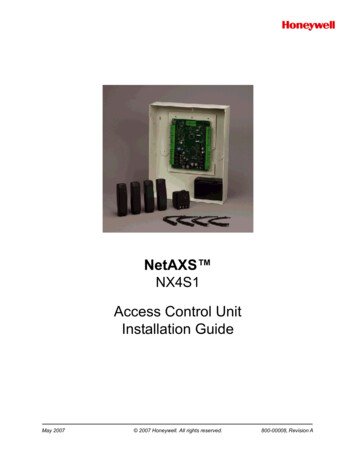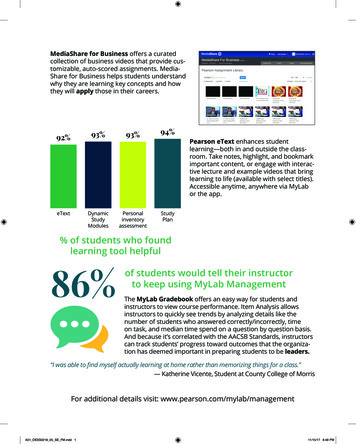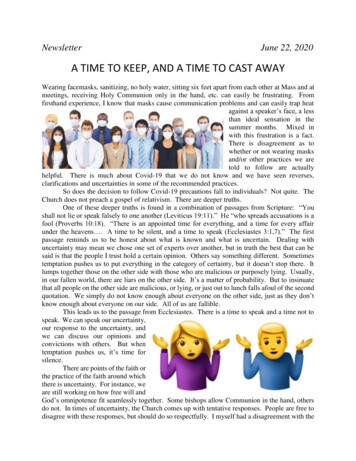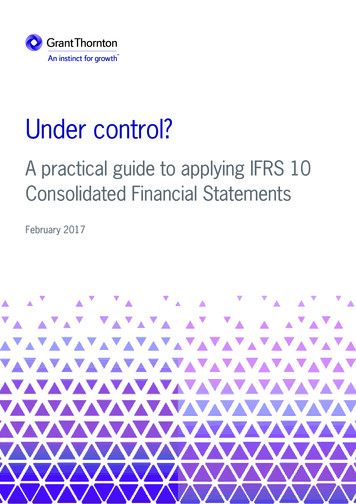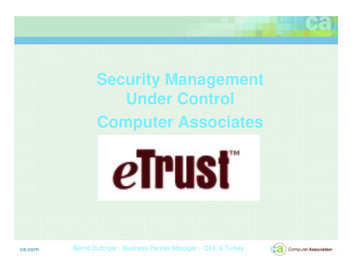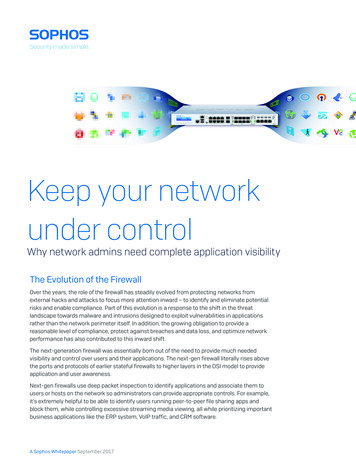
Transcription
Keep your networkunder controlWhy network admins need complete application visibilityThe Evolution of the FirewallOver the years, the role of the firewall has steadily evolved from protecting networks fromexternal hacks and attacks to focus more attention inward – to identify and eliminate potentialrisks and enable compliance. Part of this evolution is a response to the shift in the threatlandscape towards malware and intrusions designed to exploit vulnerabilities in applicationsrather than the network perimeter itself. In addition, the growing obligation to provide areasonable level of compliance, protect against breaches and data loss, and optimize networkperformance has also contributed to this inward shift.The next-generation firewall was essentially born out of the need to provide much neededvisibility and control over users and their applications. The next-gen firewall literally rises abovethe ports and protocols of earlier stateful firewalls to higher layers in the OSI model to provideapplication and user awareness.Next-gen firewalls use deep packet inspection to identify applications and associate them tousers or hosts on the network so administrators can provide appropriate controls. For example,it’s extremely helpful to be able to identify users running peer-to-peer file sharing apps andblock them, while controlling excessive streaming media viewing, all while prioritizing importantbusiness applications like the ERP system, VoIP traffic, and CRM software.A Sophos Whitepaper September 2017
Keep your network under control: Why network admins need complete application visibilityHow Next-Gen Firewall App Control WorksThe way firewalls identify applications is by matching patterns in the traffic to knownsignatures. It’s analogous to facial recognition. When you see a person’s face you don’tknow, you can compare it to a bunch of pictures, if you get a match, you know whoyou’re dealing with, if you don’t get a match, you really have no idea who that person is.“60% ofnetwork trafficis unidentifiedon average.”Application Control works exactly the same way. While some applications wear theequivalent of a name tag, making it easy to identify them, most apps don’t and someeven go out of their way to slip through unidentified. Of course, when a match is madeand an app is positively identified, the firewall can control the application – usingtraffic shaping to prioritize or limit bandwidth consumption, or block it outright. Butif there’s no match, the firewall has no idea what it’s dealing with and no control.The Problems with Next-Gen Firewall App ControlAs you can probably imagine, many applications will not provide a positive match.Many risky applications that would typically be blocked in most organizations such asBitTorrent clients use clever methods to constantly change their traffic patterns and theway they connect out of the organization in order to evade detection. This is not unlikea person changing their hair color and adding a moustache to evade facial recognition.Other applications use encryption to avoid detection which is much like a personwearing a ski mask. And many other applications will pretend to be a browser so theycan pass through the firewall unchecked. This is analogous to a bad person disguisingthemselves to look like a well known celebrity. And then there are applicationsthat have recently changed or are one-off, custom, or simply too obscure to havea matching pattern. These are like people that have no recent photo on file.In fact, as firewalls have gotten better and better at identifying and controlling unwantedapplications, these applications have gotten better and better at avoiding detection.The end result is that most of the traffic passing through a modern firewall thesedays is unknown, unidentified, or simply too generic to be classified or controlled.A Sophos Whitepaper September 20172
Keep your network under control: Why network admins need complete application visibilityDoes your App Control Report look like this?Top ApplicationsApplication NamePercentage of ApplicationsGeneral UDP25.45%General HTTPS MGMT24.26%General DNS17.8%General TCP14.39%Service RPC Services (IANA)8.86%Bit Torrent Protocol - UDP Activity 1 (Reqs SIB 5)-631.60%Conventional firewall dashboard showing categories that could not be identifiedHow big is the problem?In an effort to get a better understanding of how widespread this issue is, Sophosrecently conducted a survey of mid-sized organizations to determine how much oftheir application traffic was going unidentified and uncontrolled:ÌÌ Nearly 70% of organizations out there have a next-gen firewall or UTM with applicationawarenessÌÌ On average 60% of traffic is going unidentified and many organizations reported that up to90% of their application traffic was unidentifiedIf you’re concerned about the security, liability, or performance impact this has on yourorganization, you’re not alone ÌÌ 82% of survey respondents are rightfully concerned about the security risk this lack ofapplication visibility impliesÌÌ 65% were concerned with the impact this could be having on their network performanceÌÌ 40% were concerned with potential legal liability and compliance risksA Sophos Whitepaper September 20173
Keep your network under control: Why network admins need complete application visibilityTop concerns with the current lack of application visibility:What are your concerns with unidentified network traffic? (Multiple choice)Security concernsPerformance concernsProductivity concernsLiability & Compliance concernsPrioritization concernsVisibility concerns0%10% 20% 30% 40% 50% 60% 70% 80% 90%The Top Evasive and Unidentified ApplicationsThese evasive applications pose a high security risk due to vulnerabilities,a compliance risk due to potential inappropriate or illegal content,and a productivity and bandwidth consumption risk.ÌÌ IM and Conference Apps (e.g. Skype, TeamViewer)ÌÌ BitTorrent and other P2P Clients (e.g. uTorrent, Vuze, Freenet)ÌÌ Proxy and Tunnel Clients (e.g. Ultrasurf, Hotspot Shield, Psiphon)ÌÌ Games (e.g. Valve and Steam)Unfortunately, it’s nearly impossible for you to know if you have anyof these apps running on your network – because firewall signaturesare simply not going to find a match in most cases.In addition to these applications, there are countless more apps that are bothbenign and potentially unwanted that have resorted to utilizing generic HTTPand HTTPS connections to communicate out through the firewall, countingon the fact that nearly every organization opens up their firewall for internetaccess on port 80 and 443. In your reports, these will simply appear as HTTP,HTTPS, SSL, Web Browsing, and other general non-helpful categories.And perhaps most importantly, there are vertical applications, ERP solutions,CRM software and other business essential applications that may be unique toyour organization that are going undetected, and potentially getting crushedunder the weight of web surfing and other unwanted app traffic simplybecause they are not popular or prolific enough to have a signature.Fortunately, there’s a rather elegant solution to this problem.A Sophos Whitepaper September 20174
Keep your network under control: Why network admins need complete application visibilityThe SolutionWhile next-gen firewalls need to rely on deep packet inspection, pattern matching, andsignatures to try and identify applications as they traverse the network, the endpoint is inthe unique position where it inherently knows with absolute clarity exactly what executablesare generating all network traffic. Hence the solution, a rather obvious matter of connectingthe endpoint with the firewall to share this valuable information. Fortunately, at Sophos, wehave the technology in place to simply and effectively enable this: Synchronized Security.Sophos Synchronized Security is a revolutionary new approach to IT security that enablessecurity products to share information and work together to provide real-time insights,unparalleled protection, and automated incident response.One of the first Synchronized Security innovations, Security Heartbeat , connectsSophos Central managed endpoints with Sophos XG Firewall to share endpoint healthstatus, enabling instant identification of systems at risk. When a compromise isdetected at eithe r the endpoint or the firewall, traffic light style indicators and alertsare issued in real-time, immediately identifying the computer, user, and processinvolved. And perhaps the most important benefit of Security Heartbeat, is that thefirewall can include endpoint health status in firewall rules, enabling automatedresponse, either limiting access or completely isolating the compromised systemuntil it can be cleaned up. This has reduced response time from hours to secondsand helps reduce the risk of infections spreading to other parts of the network.Another Synchronized Security innovation is Synchronized App Control. As the nameimplies, Synchronized App Control leverages Sophos’ unique Synchronized Securityecosystem to effectively and elegantly solve the problem with identifying unknown,evasive or custom application traffic on the network. Synchronized App Control leveragesits information sharing ability with the Endpoint to determine the source of unidentifiedapp traffic on the network, effectively removing this thick veil covering networks today.Synchronized App Control in ActionApplication1 UnkownXG Firewall sees app traffic thatShares App Info2 EndpointSophos Endpoint passes app name, path anddoes not match a signatureeven category to XG Firewall for classificationInternetSecurityHeartbeat SynchronizedApp ControlXG FirewallSophosEndpointsis Classified & Controlled3 ApplicationAutomatically categorize and control where possibleor admin can manually set category or policy to applyA Sophos Whitepaper September 20175
Keep your network under control: Why network admins need complete application visibilityIt’s the first major breakthrough in network application visibility and control since the next-genfirewall was conceived.When a Sophos Central managed endpoint connects to a network with an associated XGFirewall, it will establish a Security Heartbeat connection to share health and security statusand telemetry. In addition, the endpoint will now also use this connection to share the identityof all network applications with the firewall.Where the firewall can’t confirm the identity of the application using traditional signaturetechniques because the application is evasive, custom, new or using a generic connection,the app information provided by the endpoint will be utilized to identify, classify and control it.Where possible, the applications shared by the endpoint will be automatically classified intoan appropriate category. This will automatically subject the newly identified and classifiedapplication to any app control policies that are already being enforced on the firewall.For example, an evasive BitTorrent client will be automatically assigned to the Peer-to-Peerapplication category. And if the firewall has an app control policy in effect to block Peer-toPeer apps, the new BitTorrent traffic will be automatically blocked – without any interventionby the network administrator.The Benefits:Identify Unknown AppsSynchronized App Control reveals all the apps that are currently going unseen onthe network including all new apps as well as tunneling, proxy and VPN applicationsthat often use encryption to bypass firewall control – creating an enormous blindspot as well as a variety of compliance, performance, and security risks. If thereare existing policies in place to block or traffic shape these types of applications,the newly identified applications falling into this category will be subject to thesame policies automatically. In addition the users and hosts involved will beeasily identified enabling intervention and education where appropriate.Prioritize Custom AppsSynchronized App Control will immediately identify custom business applicationsthat are completely invisible to your current firewall such as finance, CRM,ERP, manufacturing and other networked applications that are important toyour organization. For the first time, Synchronized App Control provides anopportunity to apply traffic shaping and QoS policies to ensure these missioncritical applications are getting appropriate priority and optimal performance.Control Evasive Apps“It’s thefirst majorbreakthroughin networkapplicationvisibility andcontrol sincethe next-genfirewall wasconceived.”Synchronized App Control will automatically discover all evasive applicationsthat are continuously changing the way they connect and communicate inorder to evade detection and control. In effect, Synchronized App Control putsan end to these tactics once and for all. Regardless of how evasive these appstry to be, they will be completely unable to evade Synchronized App Control.A Sophos Whitepaper September 20176
Keep your network under control: Why network admins need complete application visibilityWhich Sophos Products are Needed:Sophos provides a full ecosystem of IT security products that integrate simply toprovide Synchronized Security. Enabling Security Heartbeat and Synchronized AppControl and all the added security, visibility and control they provide couldn’t be easier.At a minimum, Sophos XG Firewall and Intercept X are required, but both productscan be deployed alongside your existing IT security infrastructure in a complementarymanner to provide Synchronized Security without any disruption or rip-and-replace.Sophos XG Firewall can be deployed either in-line with your existing firewall or as yourmain firewall gateway. It also works in a reporting and visibility only mode when XGFirewall is connected to a switch mirror port in Discover Mode (also known as TAPmode).On the endpoint, Intercept X can be deployed alongside your existing desktopAV solution, or you can choose Sophos
BitTorrent clients use clever methods to constantly change their traffic patterns and the way they connect out of the organization in order to evade detection. This is not unlike a person changing their hair color and adding a moustache to evade facial recognition. Other applications use encryption to avoid detection which is much like a person wearing a ski mask. And many other applications .
